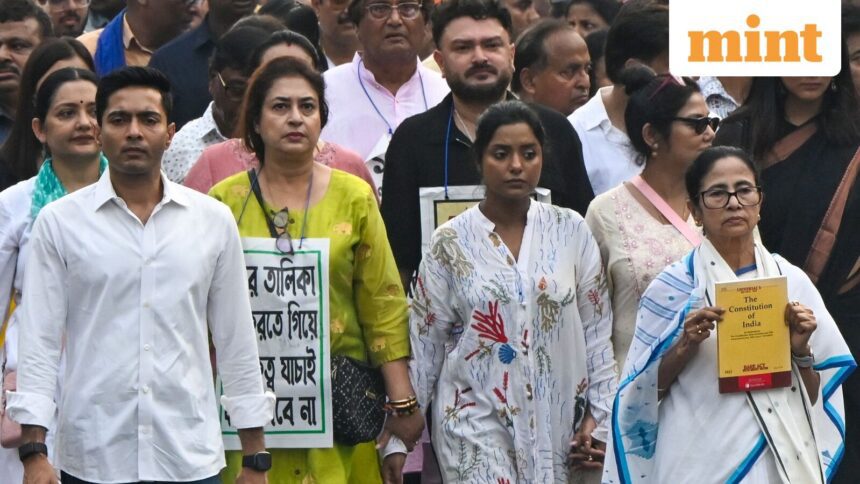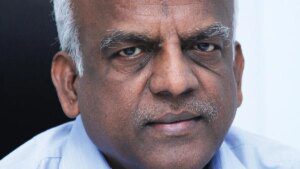Bihar is done and dusted, now get ready West Bengal.
Barely hours after the National Democratic Alliance (NDA) secured an overwhelming majority in Bihar, Prime Minister Narendra Modi sounded the ominous bugle on political rival and West Bengal chief minister, Mamata Banerjee. “Just as the Ganga flows from Bihar to Bengal, Bihar has now shown the path for the BJP’s victory in West Bengal. I congratulate the people of Bengal. Together, we will uproot jungle raj from the state,” he asserted.
The moment was infectious. Jubilation quickly spread to the BJP’s offices in West Bengal, with party workers in Kolkata’s Salt Lake and Central Avenue cheering lustily as the NDA crossed the 200-seat mark in Bihar. Flags waved, posters of Modi were hoisted, and supporters shared sweets to mark the moment. Chants of “Next is Bengal” echoed through the gatherings.
Bengal BJP state president Shamik Bhattacharya highlighted Bihar’s peaceful and incident-free Special Intensive Revision (SIR) process as a model of the NDA’s governance.
He was quick to clarify, however, that SIR is not a political `weapon’. “Our focus is on removing illegal voters in Bengal,” he said, adding that BJP had defeated Arvind Kejriwal, won Haryana, Maharashtra and Bihar, with Bengal as the next destination.
In Bihar, critics say the deletion of nearly 47 lakh voters under the Election Commission (EC) organised SIR, may have impacted the state’s poll outcome, considering omissions roughly worked out to 15,000-20,000 voters per segment in the state’s 243 assembly seats.
For the BJP, the message and the medium is clear. If a heavyweight like Lalu Yadav and his RJD can be knocked out, so can be Mamata Banerjee, who if anything, is a bigger number in the prevailing political matrix. And if that were to happen, the BJP would hardly have any opposition left in the country, save the odd Stalin in Tamil Nadu or Akhilesh Yadav in Uttar Pradesh.
But West Bengal is no Bihar and Mamata is no spent force like Lalu. On November 10, she dubbed the ongoing SIR of electoral rolls as `votebandi’ and asserted that she would protect the rights of voters at any cost, even if it meant her throat getting slashed’. Urging the EC to immediately halt the SIR, she asserted that unless the exercise was executed flawlessly, with every genuine voter included in the final rolls, its implementation in Bengal would not be as easy as it was in Bihar.
The SIR exercise was launched on November 4 in West Bengal.
Trinamool Congress (TMC) MP, Sagarika Ghose, told this reporter: “We will not allow a single legal deletion in Bengal. The party has started help camps, which will assist people in organising their documents. We will oppose the BJP’s attempt to bring in the National Register of Citizens (NRC) through the back door, in the name of SIR.’’
“Do you know that more than 10 people have committed suicide in Bengal because of their fear of being unable to produce documents? In a country where top leaders cannot produce their educational certificates, you are asking the poor for complex documentation,” she says.
Her confidence is not overstated. The TMC is widely recognised as having a strong and extensive cadre base, which is considered a key factor in its continued electoral success and its deep reach into West Bengal’s grassroots politics.
Key aspects of the TMC’s cadre strength include its ability to mobilise workers at the local level, enabling effective door-to-door campaigning and voter outreach. The party has built a robust organisational structure that helps maintain its influence across the state, even in the face of opposition challenges, now mainly concentrated in the form of the all-powerful BJP.
The party leadership, particularly Mamata Banerjee, emphasises the importance of its “own boys” (cadres) and the administration is often expected to be mindful of them, which indicates a strong party identity and loyalty.
Mamata has been in power as Chief Minister for over 14 years, serving continuously since her first assumption of office in May 2011. It is partly sustained through an intricate relationship between its political society and the people, often involving the implementation of welfare measures through its local networks.
In addition, it has successfully absorbed leaders and workers from rival parties like the Congress and CPI(M), which further bolsters its cadre strength while weakening the opposition.
Under these circumstances, taking on such a well-entrenched force – particularly in rural Bengal – is a far cry from implementing the SIR in Bihar, where key NDA leader Nitish Kumar was not just a long-standing serving chief minister with the administration on his side, but also a dedicated cadre to take on the opposition.
Clearly, though, the run-up to West Bengal assembly elections, which are due around March 2026, has all the ingredients of a battle royale.
The office of the Chief Electoral Officer (CEO) of West Bengal has received a barrage of complaints from both the ruling TMC and the Opposition BJP, since the beginning of the SIR.
Just as the Ganga flows from Bihar to Bengal, Bihar has now shown the path for the BJP’s victory in West Bengal.
On November 12, the leader of the opposition in the West Bengal assembly and BJP MLA Suvendu Adhikari visited the CEO’s office and said a delegation of the saffron party submitted a pen drive and printed copies of ‘evidence’ of around 13.25 lakh ‘fake, duplicate and dead voters’ across five assembly constituencies.
If the mood and the resolve of the ruling party and its supporters is anything to go by, that exercise may just be the beginning of a battle of attrition when dealing with a feisty Mamata.










